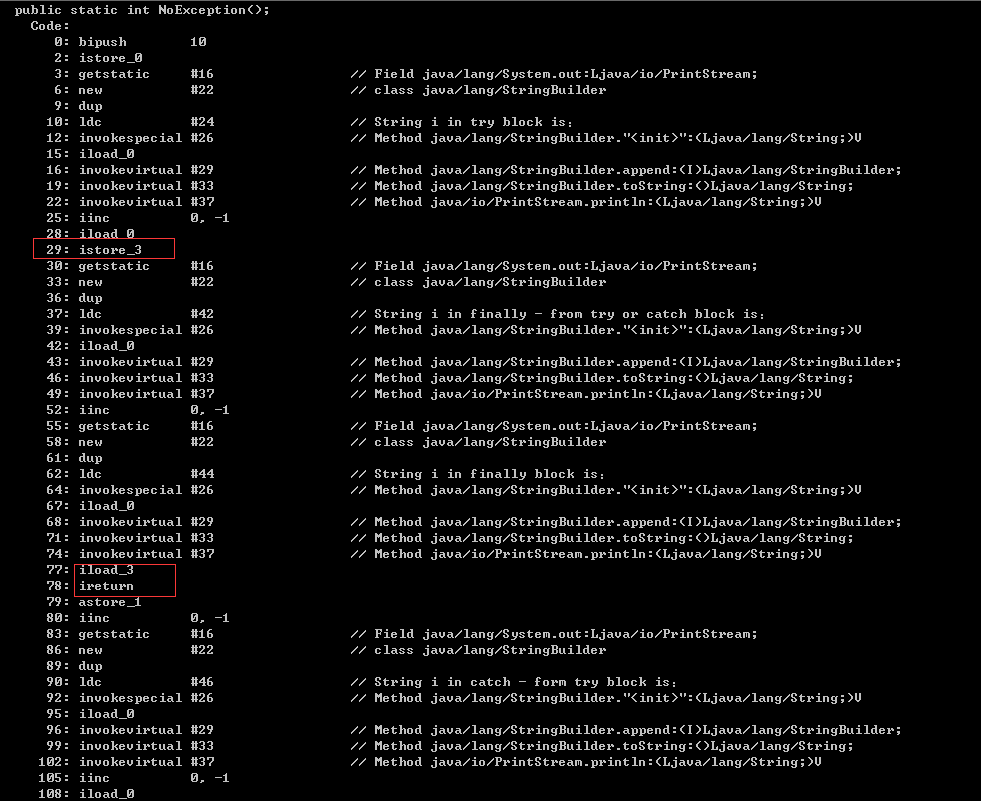1、try块中没有抛出异常,try、catch和finally块中都有return语句
|
1
2
3
4
5
6
7
8
9
10
11
12
13
14
15
16
|
public static int NoException(){ int i=10; try{ System.out.println("i in try block is:"+i); return --i; } catch(Exception e){ --i; System.out.println("i in catch - form try block is:"+i); return --i; } finally{ System.out.println("i in finally - from try or catch block is:"+i); return --i; } } |
运行代码:
|
1
2
3
4
5
|
public static void main(String[] args) { System.out.println("=============NoException=================="); System.out.println(NoException()); System.out.println("==============================="); } |
运行结果:
|
1
2
3
4
5
|
=============NoException==================i in try block is:10i in finally - from try or catch block is:98=============================== |
执行顺序:
执行try块,执行到return语句时,先执行return的语句,--i,但是不返回到main方法,执行finally块,遇到finally块中的return语句,执行--i,并将值返回到main方法,这里就不会再回去返回try块中计算得到的值。
结论:try-catch-finally都有return语句时,没有异常时,返回值是finally中的return返回的。从下面的字节码可以看出,try里的return将被忽略。


2.try块中没有抛出异常,仅try和catch中有return语句
|
1
2
3
4
5
6
7
8
9
10
11
12
13
14
15
16
17
18
|
public static int NoException1(){ int i=10; try{ System.out.println("i in try block is:"+i); return --i; } catch(Exception e){ --i; System.out.println("i in catch - form try block is:"+i); return --i; } finally{ System.out.println("i in finally - from try or catch block is:"+i); --i; System.out.println("i in finally block is:"+i); //return --i; }} |
运行结果:
|
1
2
3
4
5
6
|
=============NoException1==================i in try block is:10i in finally - from try or catch block is:9i in finally block is:89=============================== |
执行顺序:
try中执行完return的语句后,不返回,执行finally块,finally块执行结束后,返回到try块中,返回i在try块中最后的值。
结论:try-catch都有return语句时,没有异常时,返回值是try中的return返回的。

通过字节码,我们发现,在try语句的return块中,return 返回的引用变量(i 是引用类型)并不是try语句外定义的引用变量i,而是系统重新定义了一个局部引用i'(29行标红色框的,系统在这里面用第三个变量保存当前的值),这个引用指向了引用i对应的值,也就是try ,即使在finally语句中把引用i指向了值减1,因为return的返回引用已经不是i 而是临时的iload_3,所以引用i的对应的值和try语句中的返回值无关了。
3.try块中抛出异常,try、catch和finally中都有return语句
|
1
2
3
4
5
6
7
8
9
10
11
12
13
14
15
16
17
18
19
20
|
public static int WithException(){ int i=10; try{ System.out.println("i in try block is:"+i); i = i/0; return --i; } catch(Exception e){ System.out.println("i in catch - form try block is:"+i); --i; System.out.println("i in catch block is:"+i); return --i; } finally{ System.out.println("i in finally - from try or catch block is--"+i); --i; System.out.println("i in finally block is--"+i); return --i; }} |
执行结果:
|
1
2
3
4
5
6
7
8
|
=============WithException==================i in try block is:10i in catch - form try block is:10i in catch block is:9i in finally - from try or catch block is--8i in finally block is--76=============================== |
执行顺序:
抛出异常后,执行catch块,在catch块的return的--i执行完后,并不直接返回而是执行finally,因finally中有return语句,所以,执行,返回结果6。
结论:
try块中抛出异常,try、catch和finally中都有return语句,返回值是finally中的return。
4.try块中抛出异常,try和catch中都有return语句
|
1
2
3
4
5
6
7
8
9
10
11
12
13
14
15
16
17
|
public static int WithException1(){ int i=10; try{ System.out.println("i in try block is:"+i); i=i/0; return --i; }catch(Exception e){ System.out.println("i in catch - form try block is:"+i); return --i; }finally{ System.out.println("i in finally - from try or catch block is:"+i); --i; System.out.println("i in finally block is:"+i); //return i; }} |
执行结果:
|
1
2
3
4
5
6
7
|
=============WithException1==================i in try block is:10i in catch - form try block is:10i in finally - from try or catch block is:9i in finally block is:89=============================== |
执行顺序:
抛出异常后,执行catch块,执行完finally语句后,依旧返回catch中的执行return语句后的值,而不是finally中修改的值。
结论:
返回的catch中return值。
5.try、catch中都出现异常,在finally中有返回
|
1
2
3
4
5
6
7
8
9
10
11
12
13
14
15
16
17
18
19
20
|
public static int WithException2(){ int i=10; try{ System.out.println("i in try block is:"+i); i=i/0; return --i; } catch(Exception e){ System.out.println("i in catch - form try block is:"+i); int j = i/0; return --i; } finally{ System.out.println("i in finally - from try or catch block is:"+i); --i; --i; System.out.println("i in finally block is:"+i); return --i;} |
执行结果:
|
1
2
3
4
5
6
7
|
=============WithException2==================i in try block is:10i in catch - form try block is:10i in finally - from try or catch block is:10i in finally block is:87=============================== |
执行顺序:
try块中出现异常到catch,catch中出现异常到finally,finally中执行到return语句返回,不检查异常。
结论:
返回finally中return值。
6、只在函数最后出现return语句
|
1
2
3
4
5
6
7
8
9
10
11
12
13
14
15
16
17
18
19
20
21
22
|
public static int WithException3(){ int i=10; try{ System.out.println("i in try block is:"+i); i=i/0; //return --i; } catch(Exception e){ System.out.println("i in catch - form try block is:"+i); //int j = i/0; //return --i; } finally{ System.out.println("i in finally - from try or catch block is:"+i); --i; --i; System.out.println("i in finally block is:"+i); //return --i; } return --i;} |
执行结果:
|
1
2
3
4
5
6
7
|
=============WithException3==================i in try block is:10i in catch - form try block is:10i in finally - from try or catch block is:10i in finally block is:87=============================== |
总体结论:
结论一:
(1)return语句并不是函数的最终出口,如果有finally语句,这在return之后还会执行finally(return的值会暂存在栈里面,等待finally执行后再返回)
(2)try、catch、finally语句中,在如果try语句有return语句,则返回的之后当前try中变量此时对应的值,此后对变量做任何的修改,都不影响try中return的返回值
(3)如果finally块中有return 语句,则返回try或catch中的返回语句忽略。
(4)如果finally块中抛出异常,则整个try、catch、finally块中抛出异常
结论二:
finally里面不建议放return语句,根据需要,return语句可以放在try和catch里面和函数的最后。可行的做法有四:
(1)return语句只在函数最后出现一次。
(2)return语句仅在try和catch里面都出现。
(3)return语句仅在try和函数的最后都出现。
(4)return语句仅在catch和函数的最后都出现。
注意,除此之外的其他做法都是不可行的,编译器会报错。
注意:
(1)尽量在try或者catch中使用return语句。通过finally块中达到对try或者catch返回值修改是不可行的。
(2)finally块中避免使用return语句,因为finally块中如果使用return语句,会显示的消化掉try、catch块中的异常信息,屏蔽了错误的发生
(3)finally块中避免再次抛出异常,否则整个包含try语句块的方法回抛出异常,并且会消化掉try、catch块中的异常
Reference
[1] http://qing0991.blog.51cto.com/1640542/1387200
[2] https://mp.weixin.qq.com/s?__biz=MzIxNjA5MTM2MA==&mid=2652434506&idx=1&sn=f62a0cc1a18c628e1a52979921184af4&chksm=8c620fc5bb1586d3fe093e03749d9879dbbc4d540f3a68eb18b16d97d973a80a292ba6f7a0c3&mpshare=1&scene=23&srcid=0304GBqHaOULDvnnqLVyCoCk#rd